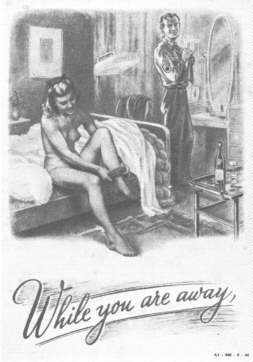
|
Love, Sex and WarJohn CostelloFrom Chapter 17: The Seeds of Sexual Revolution
|
Social costs
Even before World War II had ended, its social costs were being measured not just in the lives lost and the destruction of homes, but by the continued upswing in the barometer of illegitimacy, venereal disease, and divorce. This was taken as an indication that there had been a wartime breakdown in public and private sexual conduct and something approaching moral panic overtook church and lay organizations on both sides of the Atlantic. They began calling for firm and fast action to restore the old moral values of ‘The Married Way’ and sexual continence. Indeed so many marriages were threatened by wartime adultery that one English bishop proposed a blanket indulgence for war-separated couples who went through another religious ceremony to renew their marriage vows. (p. 356)
Statistics: Losses and casualties
A profound impact was made on the psyche of the female population by the loss of 292,131 Americans and 271,311 men of Britain in addition to the 671,278 men of the US armed forces and 277,077 British servicemen who returned home mentally and physically maimed by the war. (p. 359)
Breakdown of traditional sex roles
The breakdown of the traditional sex roles of a large section of the Allied female population was the most profound sexual consequence of World War II – even though its full impact was to take two decades to manifest itself. The female labour force, in Britain and the United States, expanded by over forty per cent during the war years. Its significance was not so much that the industrial sex-segregation barriers had been breached by women who made ships and aircraft, but that by the final year of the war three quarters of the new women workers were married. Many of these were mothers of young children who entered the workplace for the first time. In answering the urgent call to join the production battle demanded by a ‘total war,’ this large section of the female population had finally broken down the resistance to employing wives and mothers. While almost ninety per cent of women eventually married, eighty-five per cent of pre-war working women were single, whereas by 1944 a quarter of all female workers were wives and mothers. (p. 362)
Just for the duration
The wartime Transport and General Workers Union Workers organizer in Coventry, Jack Jones, was not alone in insisting that women were not in engineering ‘to cheapen the industry or to take the jobs of the men for the whole of the future, but just for the duration of the war.’ (p. 363)
Women doing men’s jobs
‘Will the Factory Girls Want to Stay Put or Go Home?’ was the question that Britain’s semi-official Mass Observation survey attempted to answer in the final year of the war. In contrast to the United States, only a quarter of British factory workers polled unequivocally answered yes to the loaded question ‘Should women be allowed to go on doing men’s jobs?’ Another twenty-eight per cent said that it ‘depends on post-war conditions,’ leaving the pollsters to conclude, ‘The most general opinion seems to be that women will want to go back home, or take up jobs which were considered suitable for women before the war, while waiting for marriage.’ (p. 366)
American propaganda
By making jobs like wartime welding seem glamorous, American propaganda fostered the impression that such work increased the chances of finding a husband and becoming a better home-keeper in peacetime. The trend was particularly apparent in the American wartime media. Women’s magazines, newspaper features on female war workers, and advertising for wartime housewives all stressed the feminine attributes. ‘She does a man’s work in the ground crew servicing airplanes, but she hasn’t lost any of her glamour, sweetness, and charm,’ ran a McCalls headline. A cosmetic company advertised that the war could not be won by lipstick, ‘But it symbolizes one of the reasons why we are fighting... the precious right of women to be feminine and lovely.’ (pp. 368-369)
Their ageless mission
That so many women responded to the post-war call to their ageless mission was to result in a larger than expected generation of post-war children who were to make a significant contribution to furthering the ‘sexual revolution’ when they matured. The ‘baby boom’ children, raised to adolescence according to the permissive ‘Spock doctrine,’ were to become participants in the sexual liberation movements which emerged in the late 1960s in the United States and had spread by the early 1970s throughout the Western world. (p. 370)
Vociferous campaigners
The women’s movement that spread its influence across the Atlantic was to become one of the most important cultural and political events of the decade. Significantly, it drew part of its inspiration and inheritance from women who had experienced a transient liberation during World War II. Now that they had raised their families and become bored with the post-war ideal of suburban domesticity, they had the time and energy to march shoulder-to-shoulder with their daughters to campaign vociferously for equal pay and legal rights, free birth control, abortions, and adequate nursery care. (p. 371)
John Costello, Love Sex and War: Changing Values, 1939-45. William Collins, London, 1985.